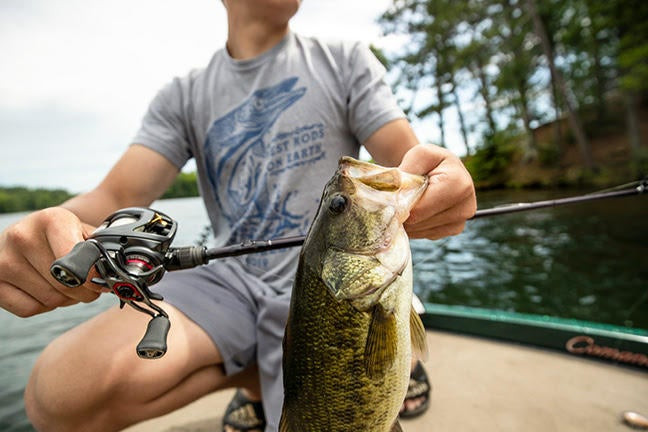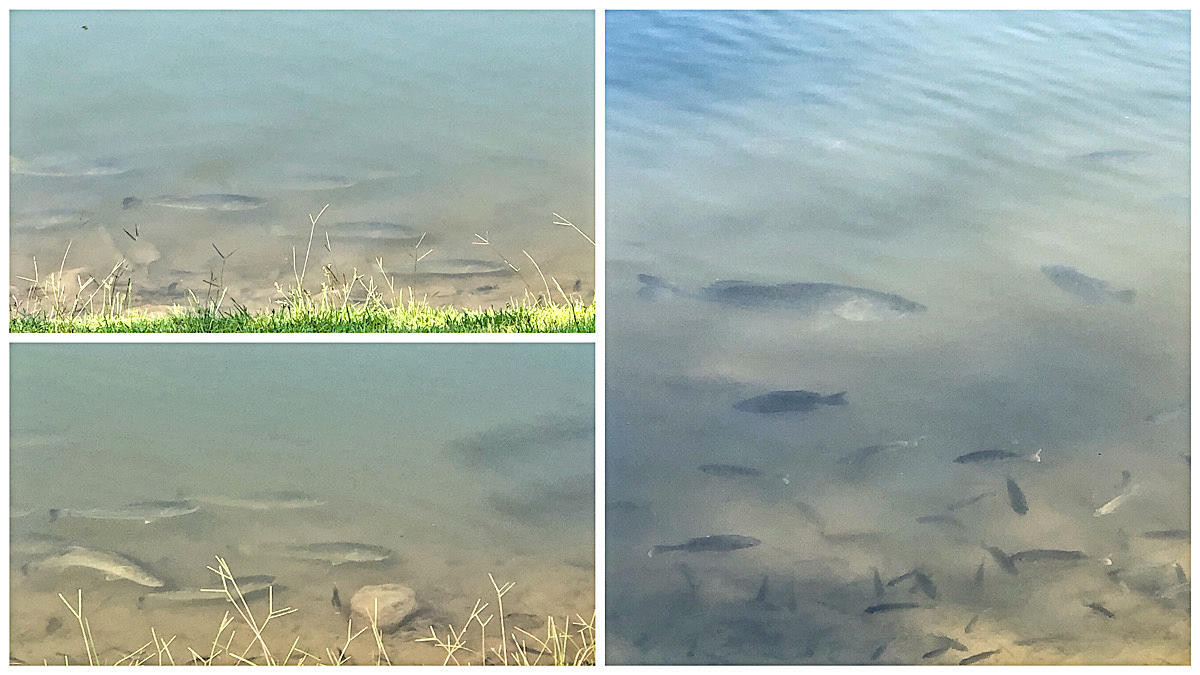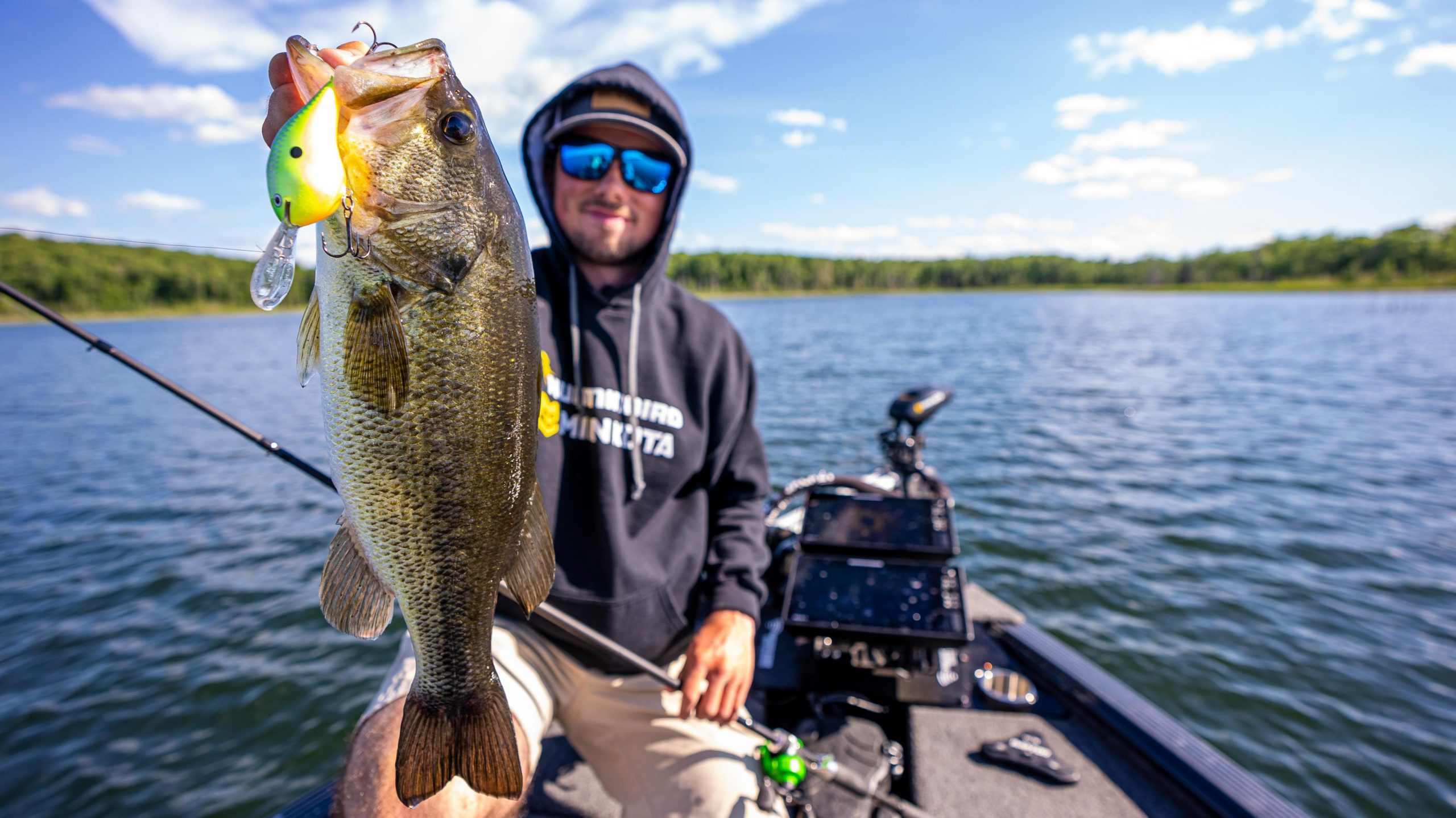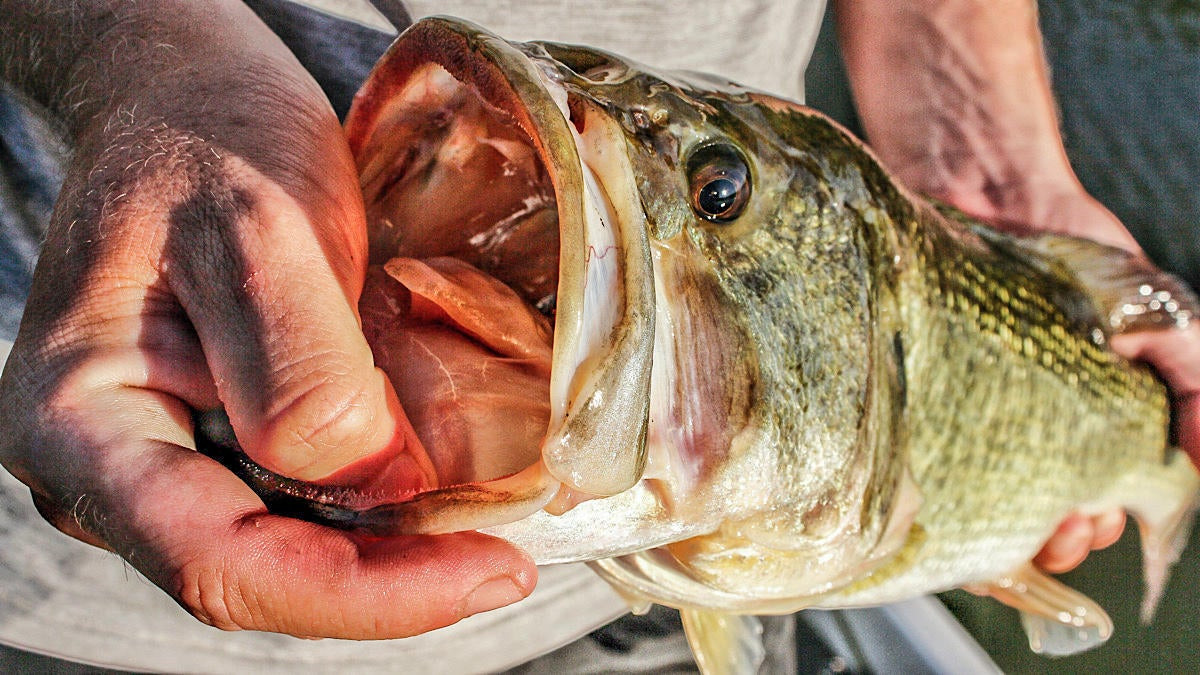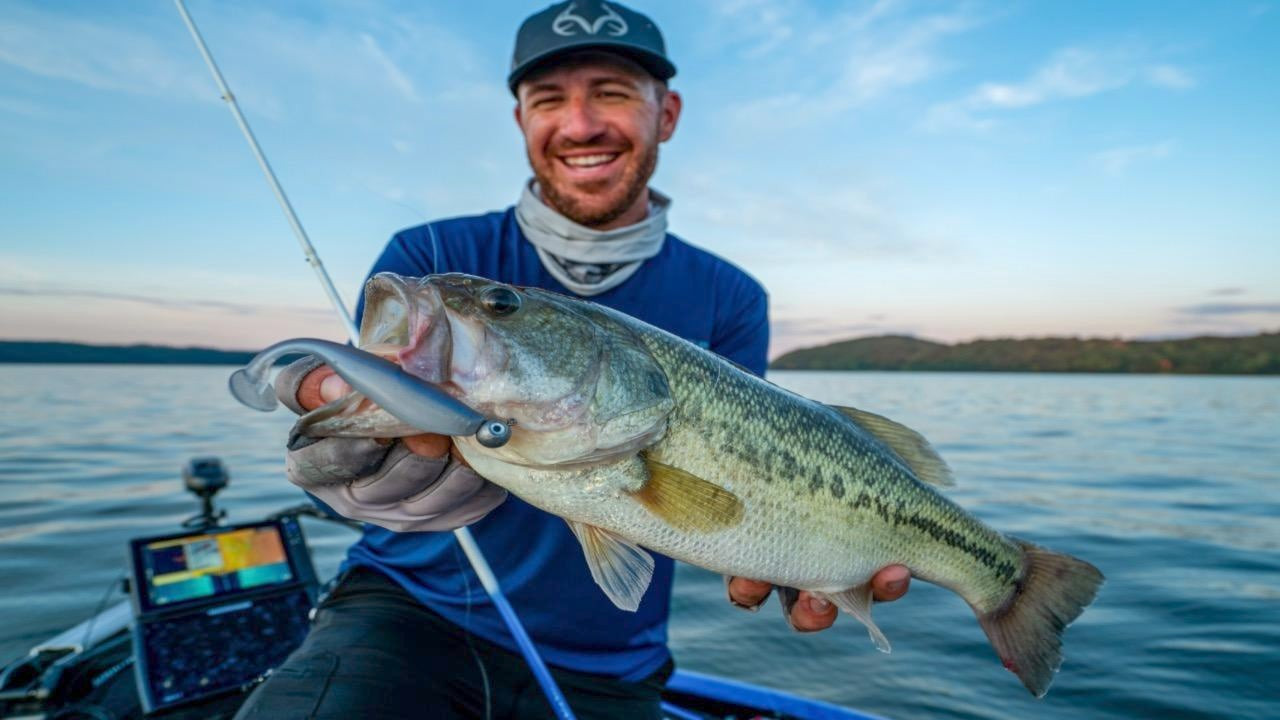Two primary factors combine to make late-summer largemouth bass challenging to catch in many water bodies. First is that they’re often widely dispersed because they’re keying in on different forage. Bass can be suspended over deep water targeting schools of suspended baitfish; in dense, shallow, oxygen-rich weeds making a living on bluegills, shiners and frogs; or found relating to offshore structure like humps, points, and ledges, often at or near the depth where the thermocline intersects the structure. Second is that bass have been pressured all summer long. Success in late-summer bass fishing often means finding more active fish that are willing to play. That requires focusing your efforts on areas with the highest concentrations of bass and showing your bait to as many as possible.
Thick Vegetation Fishing
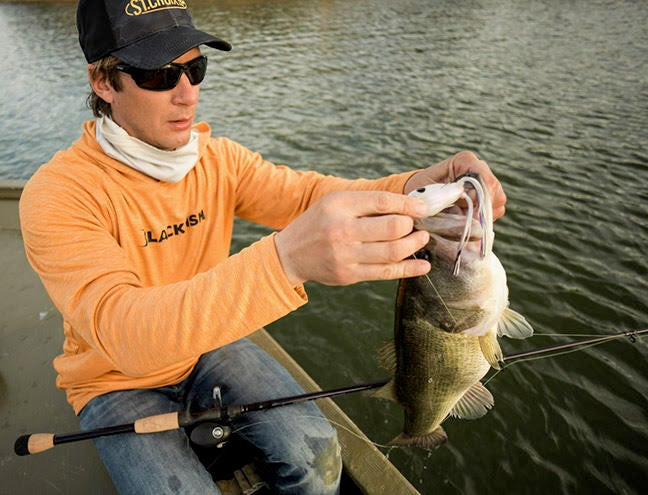
Article by Josh Lantz
By late August, weeds may either be submerged or top out on the surface. Find dense, healthy, green vegetation and you’ll likely find concentrations of bass. These areas have abundant oxygen and shade, which are good for both bass and baitfish. Three-time Junior Division National Champion, Trey McKinney of Goresville, Illinois advises starting your shallow bass hunt by working a topwater frog in the thickest green stuff you can find.
“Bass can be really pressured by late August, but there’s still a lot of fish shallow – even big ones. Frogs come over and through thick vegetation cleanly and allow you to cover water quickly while searching for active fish,” McKinney says. Key locations include anywhere vegetation exists near current, or where two different types of vegetation merge. “Look for long run out points with grass mats or even in the backs of creeks,” advises McKinney, who also likes to fish frogs through thick duckweed mats that form in slackwater pockets and coves.
“I start fishing frogs once water temps hit about 55 degrees in the spring – in current, on grass, wood, even rocks – but they really come into their own in August and September.” McKinney most often uses a Scum Frog Launch Frog tied to 65-pound braid. His preferred frog rod is a St. Croix BassX 7’4″ heavy power, fast action casting rod. “It’s got enought length and just enough tip that you can throw it a mile. Long casts are key when covering water, and when bass hit, the length helps pick up line and stick them fast. St. Croix has that same rod in its Mojo Bass Series as well, along with a 70HF and a 710HF, which make great frog rods, too.”
McKinney keeps two rods rigged when frogging, one with a fast 8.3:1 reel for bomb casting and searching, and one with a more powerful 6.3:1 reel once he’s on them. “I like the faster reel because it allows me to cover more water, but you do lose some cranking power. The powerful 74HF BassX rod with a 6.3:1 reel is an ideal setup once you stop looking and start catching. Frog bass can really get wrapped up in the weeds, so there is often a lot of pumping and cranking going on. You need power for that.”
McKinney often uses a steady walking retrieve when frogging. “I usually burn or walk them, but once I find them I slow down a bit. A cool thing about the frog bite is that if you miss a fish you can usually get them to come back up and hit again with a quick follow-up cast.”
Structure Fishing

When bass aren’t schooling out deep or marauding the shallow reeds, weeds, and pads, late-summer bass often hold on deep break lines, humps, points, ledges and other structure. Start your search by locating the depth of the thermocline on your fishfinder – the point on the water column where warmer surface water meets the cooler, deeper water.
Because cold water is denser, it’ll often show up prominently on your sonar. If the thermocline on your lake is currently at 15 feet, for example, find areas where significant structure like channel edges, points, or humps intersect that depth and you’ll often find bass in the neighborhood.
Iowa bass pros, Clay Torson and Jacob Maloney, say one of the most effective ways to target late-summer bass relating to structure is with deep-diving crankbaits like a Strike King 5XD , or with 3-inch to 5-inch swimbaits.
“Getting down and deflecting off that structure is the key,” says Torson, who has the luxury of watching the structure, the bass living there, and his lure in real time on his Garmin Panoptix LiveScope. “When using crankbaits, you’ve got to cast past the structure, crank down to it and make contact. Bass often slash the bait as soon as it deflects off the edge of the structure, especially if you give your retrieve a little pause.” Torson prefers to fish deep cranks with a 6.3:1 casting reel spooled with 12-pound fluorocarbon line.
Swimbaits on ledges

Maloney says it’s much the same with the swimbaits, which are also effective when fishing late-summer, deep weed edges. “Count it down to the depth you’re marking fish and start a slow retrieve,” he advises. “If you’re fishing structure, let it make contact. Crawl it over the rocks and let it fall a bit when you reach the edge. That’s when they tend to grab it.” Maloney most often fishes swimbaits with a 6.3:1 casting reel and 16-pound fluorocarbon line.
Lots of fish on ledges
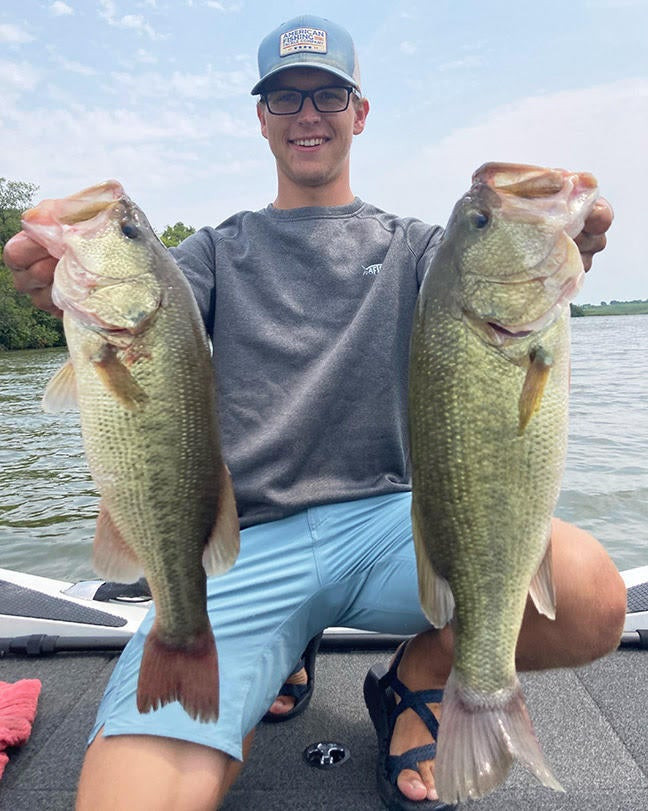
Torson and Maloney say longer rods with medium-heavy power and a moderate-fast action are ideal for both of these moving-bait presentations. “St. Croix offers a 74MHMF model in its BassX Series and a 76MHMF model in its Mojo Bass series that excel in these presentations,” Torson says. “You can go longer or shorter than that based on your personal preference, but that medium-heavy to heavy power and more forgiving action – moderate to moderate-fast – is key. Rods in this class also tend to make ideal tools for dragging Carolina rigs, which is another highly effective late-summer presentation.”
Drop Shot Fishing
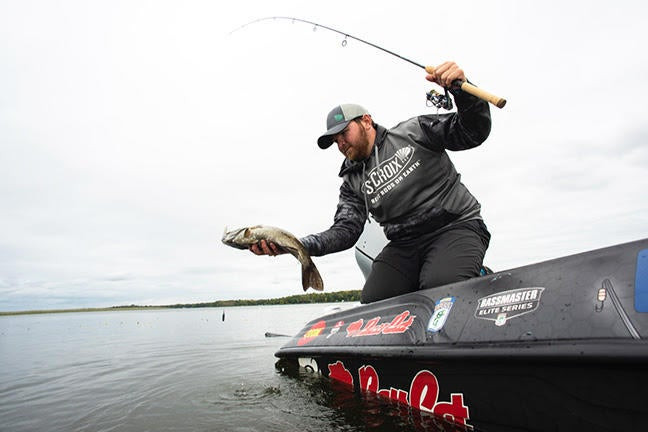
Bass relating to deep structure can be packed relatively tightly together during late summer. It can be thermocline-related, forage-related, current-related, or driven by other factors, but find a group of fish like this and you’re on what bass anglers call “the spot on the spot.” An accurate presentation is a must. Therefore, Maloney – and a whole lot of other bass anglers – capitalize on these situations by presenting baits vertically, often with a dropshot rig which has a weight at the bottom of the line and a soft-plastic bait tied in above it.
“I’ll be more aggressive with Carolina rigs and swimbaits first thing in the morning during these late-summer days, but usually end up switching to a dropshot rig fairly quickly, and it seems like it stays in my hand most of the rest of the day,” says Maloney, who gets better results this time of year moving towards larger dropshot offerings like a 6″ Roboworm fished further off the bottom. “14 to 18″ is usually about right,” says Maloney, who employs 15-pound brain mainline connected to an eight-pound fluoro leader. “Anglers might also consider fishing a bigger and longer hook when drop shotting a bigger worm like that,” he advises. Instead of nose-hooking his offering, Maloney Texas rigs the big Roboworm on a 1/0 straight-shank worm hook.
Maloney uses his electronics to find attractive structure, often in 14-18 feet of water, then pinpoints fish on the graph and continues watching it to see how the bass respond to his bait. This is relatively easy to do using today’s electronics, as the action takes place within the cone of the fish finder’s transducer, but Maloney gets even more real-time information using Panoptix LiveScope. “I drop it down and really just wiggle it a bit,” he says. “If they investigate but don’t bite it’s time to do something else. Sometimes just dragging it slowly away from them is enough to trigger a strike.
Maloney prefers a 6’10” medium-light power, extra-fast action spinning rod when drop shotting in shallower water, but moves to a longer, more powerful 7’1″ medium power, fast action spinning rod when probing deeper water. “A longer rod can help in deeper water because it gives you a bit more leverage,” reveals Maloney, who says any of St. Croix’s 6’8″ to 7’6″ medium-light and medium power BassX and Mojo Bass spinning rods with fast or extra fast tips are great options for drop shotting. “St. Croix has great dropshot rods in their other series, too, but it’s hard to beat Mojo Bass and BassX for the performance and warranty you get at a really reasonable price.”
Parting thoughts
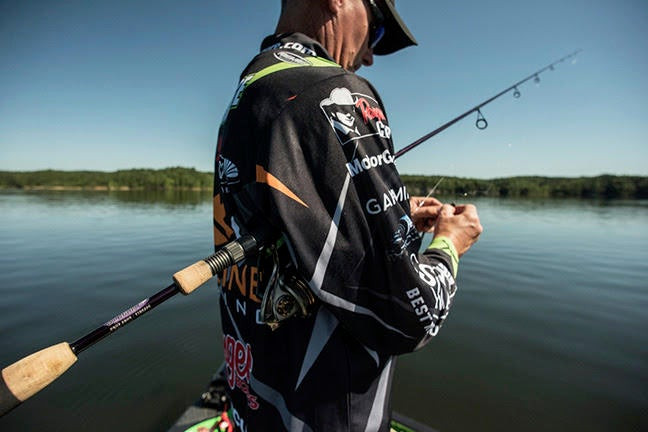
Don’t be intimidated by the dog days of summer, which often means fickle, scattered bass. Hit the water armed with the proper gear for frogging, deep cranking, and dropshotting – and these tips from our pros – and you’ll be gripping and grinning all the way into the hot bites of fall.
Next week we’ll cover late-summer multispecies presentations that are just as likely to produce walleye and pike as they are bass.
Article by Josh Lantz




